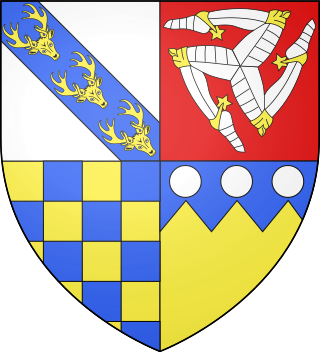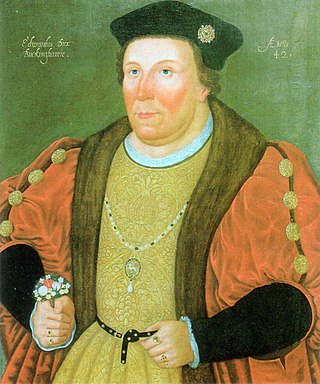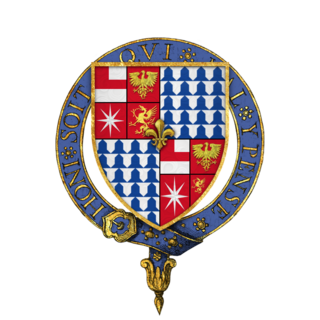Related Research Articles

Edward IV was King of England from 4 March 1461 to 3 October 1470, then again from 11 April 1471 until his death in 1483. He was a central figure in the Wars of the Roses, a series of civil wars in England fought between the Yorkist and Lancastrian factions between 1455 and 1487.

Elizabeth Woodville, later known as Dame Elizabeth Grey, was Queen of England from 1 May 1464 until 3 October 1470 and from 11 April 1471 until 9 April 1483 as the wife of King Edward IV. She was a key figure in the Wars of the Roses, a dynastic civil war between the Lancastrian and the Yorkist factions between 1455 and 1487.

Thomas Stanley, 1st Earl of Derby, KG was an English nobleman. He was the stepfather of King Henry VII of England. He was the eldest son of Thomas Stanley, 1st Baron Stanley and Joan Goushill.

Henry Stafford, 2nd Duke of Buckingham was an English nobleman known as the namesake of Buckingham's rebellion, a failed but significant collection of uprisings in England and parts of Wales against Richard III of England in October 1483. He was executed without trial for his role in the uprisings. Stafford is also one of the primary suspects in the disappearance of Richard's nephews, the Princes in the Tower.

Thomas Bourchier was a medieval English cardinal, Archbishop of Canterbury, and Lord Chancellor of England.

Anthony Woodville, 2nd Earl Rivers, was an English nobleman, courtier, bibliophile and writer. He was the brother of Queen Elizabeth Woodville who married King Edward IV. He was one of the leading members of the Woodville family, which came to prominence during the reign of King Edward IV. After Edward's death, he was arrested and then executed by the Duke of Gloucester as part of a power struggle between Richard and the Woodvilles. His English translation of The Dictes and Sayings of the Philosophers is one of the first books printed in England.

William Hastings, 1st Baron Hastings KG was an English nobleman. A loyal follower of the House of York during the Wars of the Roses, he became a close friend and one of the most important courtiers of King Edward IV, whom he served as Lord Chamberlain. At the time of Edward's death he was one of the most powerful and richest men in England. He was executed following accusations of treason by Edward's brother and ultimate successor, Richard III. The date of his death is disputed; early histories give 13 June, which is the traditional date.

Edward Stafford, 3rd Duke of Buckingham was an English nobleman. He was the son of Henry Stafford, 2nd Duke of Buckingham, and Katherine Woodville, and nephew of Elizabeth Woodville and King Edward IV. Thus, Edward Stafford was a first cousin once removed of King Henry VIII. He frequently attended the courts of Henry VII and Henry VIII. He was convicted of treason and executed on 17 May 1521.

Katherine Woodville was the Duchess of Buckingham and a medieval English noblewoman.

King Edward III of England and his wife, Philippa of Hainault, had eight sons and five daughters. The Wars of the Roses were fought between the different factions of Edward III's descendants. The following list outlines the genealogy supporting male heirs ascendant to the throne during the conflict, and the roles of their cousins. However to mobilise arms and wealth, significant major protagonists were Richard Neville, 16th Earl of Warwick, Edmund Beaufort, 4th Duke of Somerset, and Henry Percy, 3rd Earl of Northumberland, and their families. A less powerful but determining role was played by Humphrey Stafford, 1st Duke of Buckingham, and Elizabeth Woodville and their families.
The Lord of the Isle of Wight was a feudal title, at times hereditary and at others by royal appointment in the Kingdom of England, before the development of an extensive peerage system.
Events from the 1450s in England.
Events from the 1460s in England.
Events from the 1470s in England.
Events from the 1490s in England.

Thomas Grey, 2nd Marquess of Dorset was an English peer, courtier, soldier and landowner of the House of Grey.
Sir William Hawte was a prominent member of a Kentish gentry family of long standing in royal service, which, through its near connections to the Woodville family, became closely and dangerously embroiled in the last phases of the Wars of the Roses.
Katherine Neville, Baroness Hastings, was a noblewoman and a member of the powerful Neville family of northern England. She was one of the six daughters of Richard Neville, 5th Earl of Salisbury, and the sister of military commander Richard Neville, 16th Earl of Warwick, known to history as Warwick the Kingmaker.
Buckingham's rebellion was a failed but significant uprising, or collection of uprisings, of October 1483 in England and parts of Wales against Richard III of England.

Sir Edward Woodville was a member of the Woodville family during the Wars of the Roses. He survived the reign of Richard III in which several of his relatives were executed in a power struggle after the death of his brother-in-law Edward IV. Exiled with Henry Tudor, he participated in Henry's capture of the throne. Henry subsequently married Woodville's niece, Elizabeth of York. Under Henry VII, Woodville was appointed Lord of the Isle of Wight, the last person to be given that title.
References
- ↑ Powicke, F. Maurice; Fryde, E. B., eds. (1961). Handbook of British Chronology (2nd ed.). London: Butler & Tanner Ltd. p. 38.
- 1 2 3 4 5 6 7 8 9 10 11 12 13 14 15 16 17 Palmer, Alan; Palmer, Veronica (1992). The Chronology of British History. London: Century Ltd. pp. 132–135. ISBN 0-7126-5616-2.
- ↑ Stanier, R. S. (1958). Magdalen School: a history of Magdalen College School, Oxford (2nd ed.). Oxford: Blackwell.
- ↑ Clarke, D. L. L. (1980). Magdalen School: Five Hundred Years On. Oxford: Blackwell. ISBN 0-631-12516-7.
- ↑ Sylvester, Louise M.; Chambers, Mark C.; Owen-Cocker, Gale R., eds. (2014). Medieval Dress and Textiles in Britain. Woodbridge: The Boydell Press. p. 210. ISBN 9781322201160.
- 1 2 3 4 5 6 7 8 Williams, Hywel (2005). Cassell's Chronology of World History . London: Weidenfeld & Nicolson. pp. 187–189. ISBN 0-304-35730-8.
- 1 2 3 4 5 6 "A 1483 Timeline" . Retrieved 2024-01-18.
- 1 2 Penguin Pocket On This Day. Penguin Reference Library. 2006. ISBN 0-14-102715-0.
- ↑ "The Fickleness of Sabrina around Gloucester". Gloucester 500. 2021-07-22. Retrieved 2024-05-09.
- ↑ "Richard III – A Man and his Times". The Richard III Foundation, Inc. Archived from the original on 2011-01-19. Retrieved 2010-10-20.
- ↑ Moody, T. W.; et al., eds. (1989). A New History of Ireland. 8: A Chronology of Irish History. Oxford University Press. ISBN 978-0-19-821744-2.
- ↑ "The Monarchy Today > Ceremony and symbol > Ceremonial bodies > Yeomen of the Guard". Archived from the original on 28 March 2008. Retrieved 2008-03-21.
- ↑ "Margaret of Anjou | queen of England". Encyclopædia Britannica. Retrieved 2020-04-15.